Trees Birds Mammals Fish Amphibians Reptiles
Wild Algarve
Bookshop
Pholiota alnicola (Fr.) Singer - Alder Scalycap
Phylum: Basidiomycota - Class: Agaricomycetes - Order: Agaricales - Family: Strophariaceae
Distribution - Taxonomic History - Etymology - Identification - Culinary Notes - Reference Sources
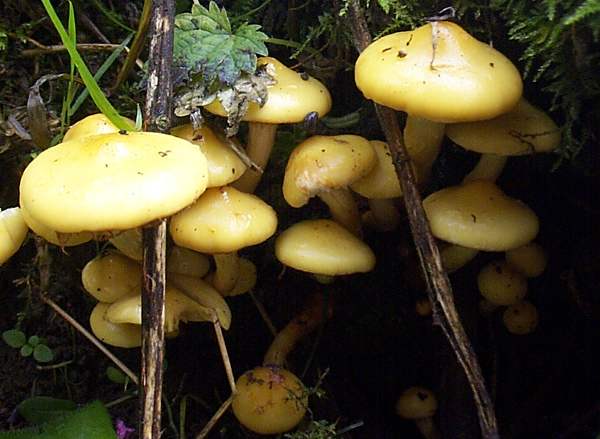
Pholiota alnicola, an uncommon species occurring
on dead or dying alder trees, is on the increase as many alder trees are
now infected by a fungal disease of the Phytopthora genus. It is one of the least scaly of the so-called scalycaps.
Look out for this and other alder-associated fungi beside rivers and lakes and in alder carr (wet) woodland. (The specimens shown here were found growing on a fallen alder beside a small river in West Wales.)
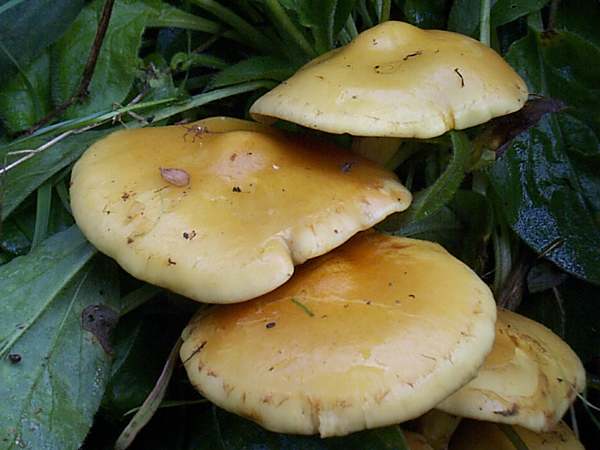
Distribution
An uncommon and in many areas rare species in Britain and Ireland, Pholiota alnicola is also found in northern and central mainland Europe as well as in Asia and parts of North America.
Taxonomic history
Described in 1838 by the great Swedish mycologist Elias Magnus Fries, who gave it the name Agaricus alnicola (most gilled fungi being placed in the Agaricus genus at that time), this saprobic mushroom species was transferred to the genus Pholiota in 1949 by German-born mycologist Rolf Singer, thus establishing its currently accepted scientific name.
Synonyms of Pholiota alnicola are many and various, as is so often the case with large and conspicuous mushrooms; they include Pholiota flavida, Agaricus alnicola Fr., Agaricus apicreus Fr., Flammula alnicola (Fr.) P. Kumm., Flammula apicrea (Fr.) Gillet, Dryophila alnicola (Fr.) Quél., Pholiota alnicola (Fr.) Singer, Pholiota aromatica P. D. Orton, and Pholiota apicrea (Fr.) M.M. Moser.
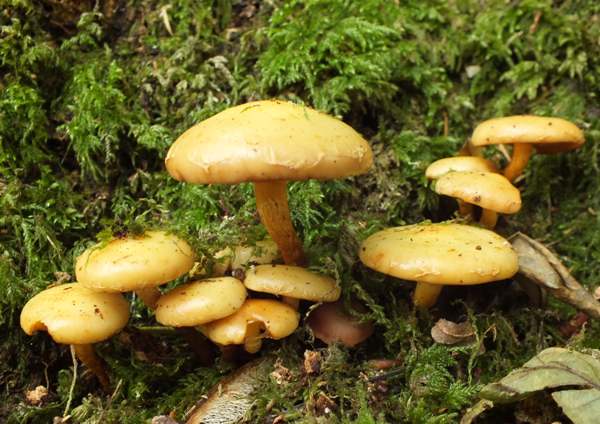
Etymology
The generic name Pholiota means scaly, and the specific epithet alnicola is a reference to the Alder trees (Alnus species) upon which these mushrooms most commonly occur
Identification guide
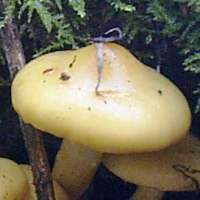 |
Cap
2 to 8cm in diameter, bright yellow and with
a greasy surface in wet weather. Veil fragments often cling to the cap
margin. |
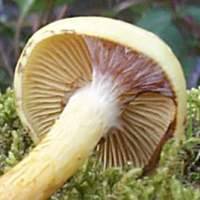 |
Gills
A cortina-like veil covers the gills of young
caps.
The crowded adnate gills are lemon yellow, turning cinnamon as the
spores develop.
Stem
5 to 10mm in diameter and 3 to 7cm tall; lemon-yellow becoming rust-tinged
towards the base; smooth surface, with a pale ring zone (retaining fragments
of the partial veil). The stem is solid with fibrous yellow flesh. |
| |
Spores
Ellipsoidal, smooth, 8.5-11.5 x 5-5.5μm; with a distinct germ pore.
Spore print
Reddish-brown. |
Odour/taste |
No distinct odour; taste is rather bitter. |
Habitat & Ecological role |
On stumps and dead trunks and branches of
alder, willow and birch; beside streams and lakes and in other shaded,
damp places. |
Season |
September to December in Britain and Ireland. |
Similar species |
Kuehneromyces mutabilis can be very similar, although its cap is usually two-toned. It also has a
more obvious sign zone and a dark tan stem below the ring zone; its gills
are ochraceous when young, becoming cinnamon at maturity. |
Culinary Notes
Despite their attractive appearance, these and other scalycaps (Pholiota species) are definitely not edible mushrooms, although in the past some members of this genus were considered to be so.
Reference Sources
Fascinated by Fungi, 2nd Edition, Pat O'Reilly 2016, reprinted by Coch-y-bonddu Books in 2022.
British Mycological Society (2010). English Names for Fungi
Funga Nordica, Henning Knudsen and Jan Vesterholt, 2008.
Dictionary of the Fungi; Paul M. Kirk, Paul F. Cannon, David W. Minter and J. A. Stalpers; CABI, 2008
Taxonomic history and synonym information on these pages is drawn from many sources but in particular from the British Mycological Society's GB Checklist of Fungi.
Top of page...
Fascinated by Fungi. Back by popular demand, Pat O'Reilly's best-selling 450-page hardback book is available now. The latest second edition was republished with a sparkling new cover design in September 2022 by Coch-y-Bonddu Books. Full details and copies are available from the publisher's online bookshop...